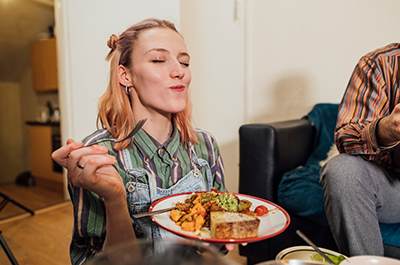Thanksgiving is marked by the overabundance of food – with turkey as the start of the show. And when you’re in charge of cooking this signature dish, the task can seem very daunting.
From thawing to preserving leftovers, this guide to all things turkey will help you stay on top of your Thanksgiving cooking and leave you feeling confident about navigating the kitchen.

How to Safely Thaw a Turkey
Thawing your turkey is the first step in the Thanksgiving process. Depending on the size of your bird, and how you choose to unthaw it, the timing may vary. While frozen turkeys are safe from bacteria growth, make sure they defrost at a safe temperature. When the turkey is left out at room temperature for more than two hours, temperatures can creep into the bacteria-growth danger zone, which is between 40 and 140 degrees. If you choose to use cold water to thaw your turkey, be sure to change the water every 30 minutes.
How to Safely Handle a Turkey
Above all, it’s important to avoid the spread of germs caused by dirty utensils, work spaces and even your own hands.
To stop bacteria from spreading to your food and family once your turkey is thawed, wash your hands thoroughly with soap and running water. Also make sure your cooking supplies have been cleaned before you start – as well as in between preparing different foods like raw meats – to avoid cross-contamination.

How to Safely Cook a Turkey
Before cooking your turkey, ensure it is completely thawed. If it isn’t, your cooking time will increase. Other variables can affect cooking time:
Increases cooking time
- Stuffing inside the turkey
- Shiny metal pans
- Deep cooking plans
Decreases cooking time
- Dark roasting pans
- Oven cook bags
- Using a roasting pan lid
Now that you have your turkey prepared and ready to put in the oven, how do you actually cook it?
- Set your oven. Set your oven to a temperature no lower than 325 degrees. You don’t need to wait for it to preheat before putting your bird in.
- Stuff your bird. If you plan to stuff your turkey, prepare stuffing before and loosely fill the turkey. Then, place your bird breast-side up on the oven rack in a shallow roasting pan (2 – 2 ½ inches deep will work).
To prevent overbrowning, place a tent of aluminum foil loosely over the breast of the turkey for the first 1 – 1 ½ hours, then remove for browning or place a tent of foil over the turkey after it has reached the desired golden brown color. - Cook for the recommended time. Use the chart to determine how long to cook for your specific sized turkey.
- Check if it’s completely done. To do this, put a food thermometer in the innermost part of the thigh and wing, and the thickest part of the breast. Is the temperature 165 degrees? If yes, then you’re good to go.
Are you getting hungry yet? If so, you’re in luck. Let the turkey cool for about 20 minutes before removing the stuffing, carving and, finally, feasting.
How to Store and Reheat Leftovers
One of the best parts of Thanksgiving? Having lots of leftovers to snack on in the days after the holiday. But while leftovers taste great, they might be wreaking havoc on your body - especially if they aren't stored correctly.
To prevent food poisoning, refrigerate any leftovers in a sealed container at 40 degrees or below as soon as possible and within two hours of preparation. When reheating leftovers, heat to 165 degrees to kill any bacteria.
Cooked turkey and other Thanksgiving dishes can last three to four days in the refrigerator and indefinitely in the freezer – although their quality starts to decrease after four to six months.



